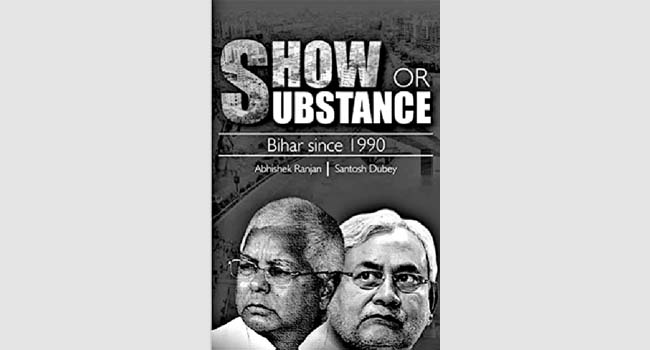Abhishek Ranjan & Santosh Dubey’s Show or Substance Bihar since 1990 is a detailed study of Bihar right from Lalu Yadav arrived at the helm of affairs three decades ago to the present times. The book is a must-read for anyone who will like to understand the State and what made it like the way we see it today
–Siddhartha Ghosh

The title of the book is a short and precise one as people, who are familiar with the State will generally accept that politicians from Bihar were either show or substance or a cocktail of both most of the time. The book covers aspects of Bihar at the policy level like governance, poverty and migration, family planning and healthcare, to name a few.
The writers in the preface refer to the 1990s when kids from Bihar were encouraged to leave and study outside of Bihar for their higher education. This will resonate with anyone who has seen that time. Both of the writers are migrant Biharis and have a unique perspective to decode the Bihari identity and the narrative of backwardness and development, which has been woven around the same. They go on to say that they have written the book to compare the works done in the last three decades in Bihar by the state governments primarily led by two persons – Lalu Prasad Yadav and Nitish Kumar. They are hopeful that the book will provide a sort of guidance to the future government which is going to be elected in the state polls of 2020.
The book is divided into chapters that are critical policy decisions for any state to develop itself. The first chapter though is a detailed description of the politics that have been played by various parties in Bihar. It provides a snapshot into the kind of politics which brought Lalu into power and the subsequent shift in Bihar after 2004 when Nitish Kumar got his chance to rule. It provides a critical assessment of the prominence of caste-based politics in Bihar and its subsequent impact on governance. It also provides a summary as to how the State looks today on political terms while giving out general scope and methodology which has been implemented by the writers in the subsequent chapters.
The later chapters are dedicated to the broader policy/sector context of the State. The book has used data from various periods between 1990 and 2020 to evaluate where Bihar stands on various aspects of development and public welfare. In some cases though, there is an acute shortage of data available for any year before 2005 due to improper records kept for that period. It has been a limitation of the study and has been highlighted by the authors themselves. That being said, the book succeeds in providing a general idea for critical aspects of development like family planning, elementary education, agriculture, infrastructure, industrial development, and investment, to name a few.
The book advocates for political will, and the need for developing Bihar while sticking to the roots than choosing the easier way of migration. Overall, the book is an excellent source to understand Bihar better while also serving as a source of data and references for the State. It gives a crash course of policy decisions made in the State in the last 30 years. It’s a must-read if you are interested in knowing about Bihar as a whole, and what lies ahead for its people
The last few chapters are dedicated to the future of Bihar, which can be made possible by thoughtful policy changes and implementation at the ground level. The rise of urbanisation has been noticed in Bihar, which is mostly seen as a predominantly rural population. The 131% growth in urbanisation in the last six years shows no distinct patterns other than being heavily centred around the State’s capital Patna.
In the second last chapter of the book, the authors give out the vision for a new Bihar. The authors suggest poverty alleviation, health care reforms, revamping of the education system among various other suggested reforms that are critical to the future development of the State.
The authors have also mentioned the demand for the special status of Bihar. They advocate for a stimulus package that can be used for modernising agriculture, rapid industrialisation, enhancing infrastructure, and improving tourism industries in Bihar along with the development in other sectors as well. They also identify an urgent need for addressing the problems of social & financial inequalities, gender discrimination, rampant poverty and low quality of life among the residents of Bihar.
The last chapter penned by Santosh Singh (Assistant Editor, The Indian Express) proposes the way forward for Bihar, should it aim for fast-paced development to compare itself with other developed states in India. The authors beautifully narrate the limbo in which Biharis are caught upon, one being with Nitish Kumar’s model of development involving “Bijali, Sadak and Paani” while the other end being with populist assurances of Tejashwi Yadav who promises 10 lakh jobs, loan waiver to farmers and pay parity to para teachers. And while political fights are only till the elections, other aspects like revenue generation, annual floods, development of educational institutions of excellence, pending land reforms among many others are generally neglected.
The book advocates for political will, and the need for developing Bihar while sticking to the roots than choosing the easier way of migration. Overall, the book is an excellent source to understand Bihar better while also serving as a source of data and references for the State. It gives a crash course of policy decisions made in the State in the last 30 years. It’s a must-read if you are interested in knowing about Bihar as a whole, and what lies ahead for its people.
(The writer is a research scholar at Mahatma Gandhi Central University, Motihari, Bihar)














Comments